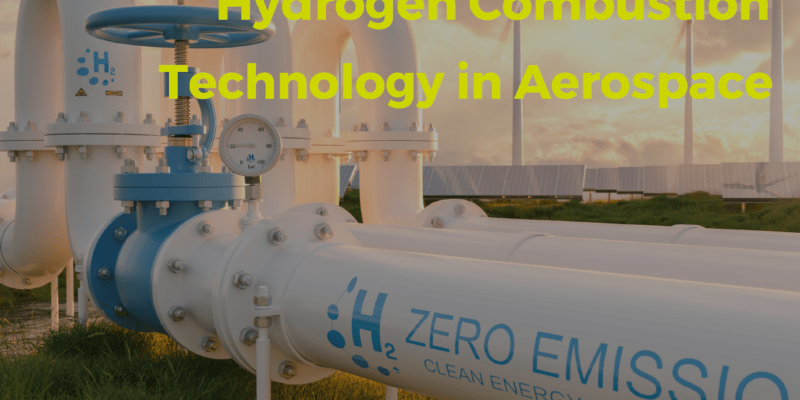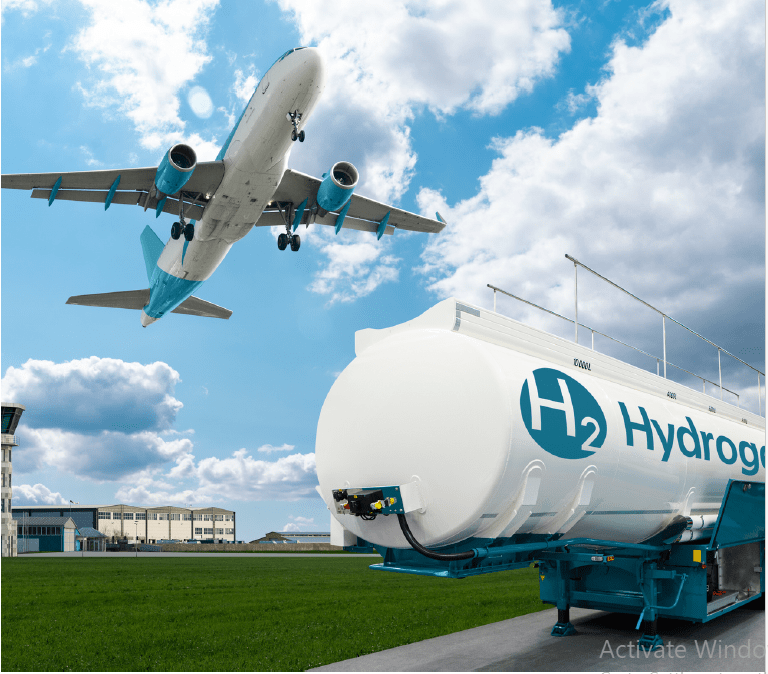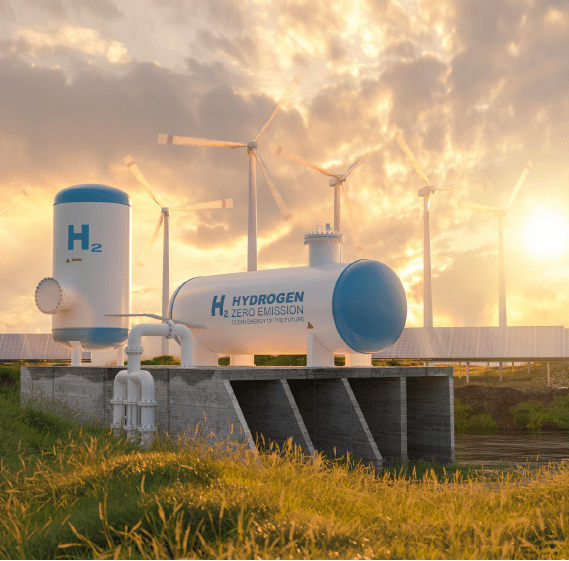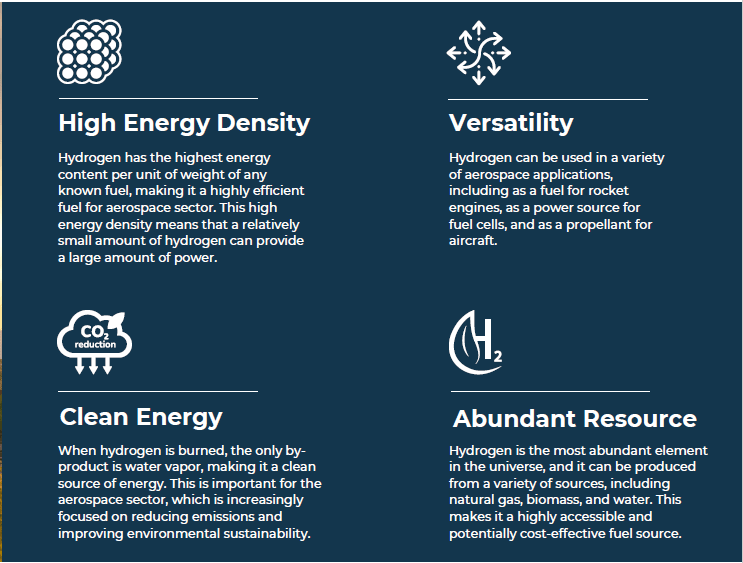
- April 25, 2023
- By admin_panel
- Comments 0


Quick Highlights






Introduction
Hydrogen combustion technology in aerospace refers to
the use of hydrogen as a fuel in aircraft combustion
engines, such as gas turbine engines. Hydrogen is an
attractive fuel for aerospace applications because it has
high energy content, burns cleanly, and produces no
carbon dioxide emissions.
In a hydrogen combustion engine, hydrogen is mixed with air and ignited in a combustion chamber. The resulting energy is used to power the engine's turbines,
which drive the aircraft's propellers or fans. The combustion process produces only water vapor as a byproduct, making it a clean and environmentally friendly
alternative to traditional fossil fuels.
Today, hydrogen is commonly used as rocket fuel due to its
property of high specific impulse, which means rockets can
accelerate to very high speeds in order to escape the earth's
gravitational pull and travel to space. However, this is not the
case with aircraft, where storage, safety, and infrastructure
are major challenges.

Hydrogen - A potential fuel for aerospace
According to IATA (International Air Transport Association), aerospace sector produces 900 million tons of CO2 per year and if nothing is done to cut carbon emissions, the aerospace sector is projected to emit 1.8 billion tons of CO2 by 2050. Hence, in this context, hydrogen combustion technology could potentially benefit the aerospace sector in the future.
Despite challenges there several reasons why hydrogen is seen as a potential fuel for the aerospace sector.


Challenges
The use of hydrogen as a fuel for aircraft combustion engines presents several challenges, including:
Storage: Hydrogen has a low
volumetric density, and it requires a large amount of storage space to carry enough fuel to power an aircraft. The high-pressure tanks required to store hydrogen can be
heavy and take up a significant amount of space on the aircraft.
Safety: Hydrogen is highly
flammable and can ignite easily, making it a safety concern for aircraft applications. The highpressure storage tanks needed for compressed hydrogen can also be prone to leaks, increasing the risk
of accidents.
Infrastructure: Hydrogen refuelling infrastructure is not as widely available for aircraft as it is for rockets. This means that aircraft would need to be designed
to carry enough hydrogen for their entire flight, which can be challenging given the storage and safety concerns
mentioned above.
Cost: The cost of producing and storing hydrogen is currently higher than conventional aircraft
fuel, which could make it less economically feasible for airlines to adopt.
Range: The volumetric density of hydrogen is lower than that of conventional aircraft fuels,
which could limit the range and payload capacity of aircraft
using hydrogen fuel.
Top companies
Here are the notable companies working to develop hydrogen combustion technology.

Top start-ups
Here are some of the notable startups developing hydrogen combustion technology.

This is a popular US based aerospace
startup focused on developing hydrogenelectric
aircraft. Interestingly, the
company created history this year by
flying the largest aircraft ever powered by
a hydrogen-electric engine.

This is an aviation & aerospace startup based
out of Stuttgart in Germany. The company is
focused on developing advance powertrain
systems for hydrogen powered aircraft. In April
2022, its HY4 aircraft achieved a new world
record by flying above 7000 ft for the first time.
Latest Developments
Hydrogen combustion technology continues to be an important area of research and development. Here are some recent updates on the use of hydrogen combustion technology in aerospace sector:

Rolls-Royce and easyJet
In Nov 2022, Rolls-Royce and easyJet confirmed of successfully tested hydrogencombustion
technology using a converted Rolls-Royce AE 2100-A regional aircraft
engine. The test was conducted using green hydrogen created by wind and tidal
power.
Raytheon Technologies
In July 2022, Raytheon Technologies was selected by the U.S. Department of Energy
for undertaking projects to test hydrogen as a fuel. First project is to test the
operation of Mitsubishi Power Aero's FT4000® gas turbine unit using hydrogen. And
Second project to develop hydrogen-fuelled propulsion tech for commercial aircraft.


Airbus
In November 2022, Airbus revealed of developing a hydrogen-powered
fuel cell engine. The company will start testing this engine on its ZEROe
demonstrator aircraft. And if the development is successful, the engine
could carry 100 passengers for around 1000 nautical miles.
Honeywell
This year in January Honeywell made an announcement of developing a fuel cell
propulsion system powered by hydrogen. The propulsion system will be integrated
and tested by Pipistrel Vertical Solutions, a Slovenia -based aviation manufacturer.


GE Aerospace
In December 2022, Avio Aero, a subsidiary of GE Aerospace, had undertaken the
"AMBER" hybrid electric technology demonstration programme in Europe. The
objective of the programme is to develop hybrid electric propulsion for aircrafts
powered by hydrogen.
Siemens
In 2022, Siemens introduced “Digital Twin”, a simulation tool where
engineers can model for hydrogen fuel cells and gas turbines. These
models allow for the prediction and rectification of any future designphase
hurdles.

GKN Aerospace
In November 2022, GKN Aerospace successfully developed a demonstrator of a
liquid hydrogen aircraft fuel system. The aim of the development was to test the
feasibility of using a liquid hydrogen fuel source.


Boeing
Last year, Boeing successfully tested a cryotank designed for space with the
capacity to hold 16,000 gallons of liquid hydrogen or the energy equivalent of
the fuel in a typical regional jet.
Key M & A s


ZeroAvia has acquired a leading fuel cell stack
innovator HyPoint. The acquisition will provide
ZeroAvia with innovative high fuel cell
technology for boosting the power output and
energy density of aircraft fuel cell powertrains.
Recently, GKN Aerospace and easyJet have entered
into a strategic partnership. Through this
partnership easyJet will support the development of
GKN Aerospace’s Hydrogen Combustion (H2JET)
and Hydrogen Fuel Cell (H2GEAR) technology.


Honeywell has acquired Ballard Unmanned
Systems. With the acquisition, Honeywell will be
able to access the market for hydrogen fuel cells for
unmanned aerial systems & other types of aviation
applications. Ballard Unmanned Systems is a leader
in producing stored-hydrogen proton exchange
membrane fuel cell systems.
Last year, Rolls-Royce announced a ground-breaking
partnership with easyJet. Both the companies have
expressed commitment to collaborate on a series of
engine tests on the ground. The partnership's goal is
to develop hydrogen as a potential fuel for the
aerospace sector.

The acquisition sheds light on the importance of using thermoplastic composites material for high-rate
aircraft production. With fuel space utilization being a hurdle to the adoption of hydrogen in the aerospace
domain, the use of thermoplastics will allow for the creation of lighter and more fuel-efficient aircrafts.
Quick Market Projections
Here are some quick market projections to showcase growth in hydrogen combustion technology.
Europe in particular is turning out to be
the main driver of the hydrogen aircraft
market. Particularly those countries in the
European Union (EU) such as Germany, UK
and France. For example, the grants
provided to the H2GEAR programme by
the UK government. The objective of the
programme is to develop aircrafts
powered by hydrogen for commercial
purpose with major companies like GKN
Aerospace driving the programme.
According to marketsandmarkets, the hydrogen aircraft market is expected to reach USD 7,427 million by 2030, from USD 143 million in 2020 at a CAGR of 28.9% during 2025 to 2030.

Over the projected period,
North America is anticipated to
control the hydrogen
aerospace market globally.
North America is followed by
Europe, Asia-Pacific, Latin
America, and the Middle East
and Africa.
Quick Patent Insight
Notable Patents
US20220403980A1

Title: Storage tank for liquid hydrogen
Assignee: Rolls Royce
Filing Date: 2022-05-26
The patent elaborates about design of a storage tank for liquid hydrogen. The
objective of the patent is to ease the complex manufacturing associated with
liquid hydrogen storage tanks.
US11448133B2

Title: Moderate pressure liquid hydrogen storage for hybrid-electric propulsion system
Assignee: Raytheon Technologies Corp
Filing Date: 2021-03-26
The patent elaborates about a turbine engine with a liquid hydrogen storage.
The objective of the patent is develop hydrogen storage that is configured to
maintain liquid hydrogen pressure below 20 bar.
US11462763B2

Title: Aircraft fuel cells system
Assignee: Airbus
Filing Date: 2020-09-21
The patent elaborates about hydrogen fuel cell system for an aircraft. The
objective of the patent is to develop a hydrogen fuel cell system that will power
multiple systems on an aircraft without generating carbon emissions.
US20220297844A1

Title: Hybrid electric hydrogen fuel cell engine
Assignee: Boeing
Filing Date: 2022-01-13
The patent elaborates about an aircraft propulsion system powered by fuel cells.
The objective of the patent is to develop an aircraft engine system where
hydrogen is the main source of power for its functionality
WO2021074643A1

Title: Aircraft fluid release system
Assignee: GKN Aerospace
Filing Date: 2020-10-16
The patent elaborates about fluid release system for a hydrogen fuel cell. The
objective of the patent is to develop a controllable water discharge arrangement
to control the outflow of fluids produced while using hydrogen as a fuel.
US20220145801A1

Title: Hydrogen fuel system
Assignee: General Electric
Filing Date: 2021-09-14
The patent elaborates about a hydrogen fuel system for an aircraft. The
objective of the invention is to develop a fuel system that can effectively use
hydrogen as fuel and overcome the challenges that arise when hydrogen is in a
gaseous state.

